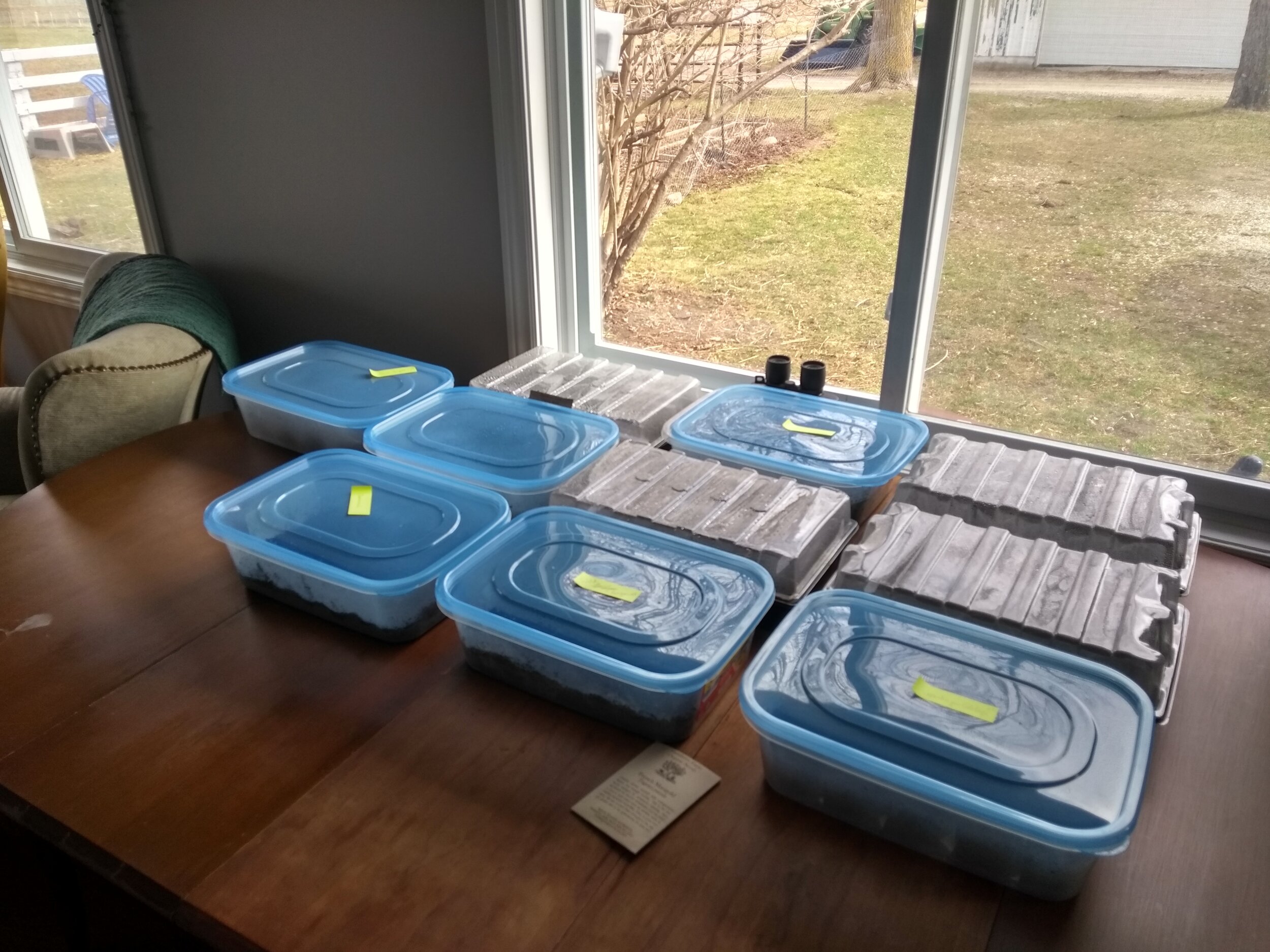Peppers 2020
Started April 1
Peppers, hot and sweet
Chinese Five Colour (Hot)
Size: 12-18” high by 12” wide
Location: full sun, they prefer cool, moist roots
Matures in: 75 days red
Native to: China
Why did I Choose it? All the pretty colours and tasty too.
Uses? Great for hot sauce, pickling, and canning. You can freeze them too if you have too many.
Specifics: Showy green foliage with purple stems and vines.
The fruit is thumbnail size and the peppers start out purple and then turn cream, yellow, orange and finally red. All of the colours can be present at the same time.
Plants do well in the ground or in containers. Containers can be brought inside to overwinter giving them a headstart for next year.
They are 4-20x hotter than jalapenos, having the same kind of heat as cayenne peppers, with sweetness and flavour not just heat.
Companion Plants:
Buckwheat repels European corn borer that can devastate pepper plants.
Basil repels fruit flies and some beetles.
Alliums deter aphids and beetles.
They thrive in the sun but prefer cool moist roots so any low ground cover can work such as strawberries, oregano and marjoram.
Planting them close together will also help them to grow better.
They have root exudates that prevent root rot so plant near plants that can benefit from this.
They also like cucumbers, eggplant, swiss chard, squash, parsley and rosemary.
Tea made from hot peppers is a good insecticide.
Avoid:
Beans, broccoli, cabbage, cauliflower, brussels sprouts and fennel
Personal Notes: I didn't have grow lights or seed heat mats last year and my peppers really paid the price. It took 2 weeks for any to start sprouting and they stayed very small in the pots, even when potted up, I got reasonable germination. Hawthorn gives 90% germination and I found that to be true. I probably should have started them earlier too from what I’ve seen for our area. They got established outside but really only started taking off by the end of summer. There were lots of little purple peppers on the plants that survived transplant but they didn't get to ripen before the first frost. I covered them at first but then forgot one night and lost all of them Hopefully this year we’ll have better success.
Makeshift greenhouses using plastic tubs and paper pots
Amish Pimento (Sweet)
Amish Pimento Sweet Pepper
We did get lots of little green peppers and I did use some in salsa, but they never got red.
Size: 12-30” tall by 12” wide
Location: lots of sun, sheltered from the wind, will not set fruition cold or extremely hot temperatures or drought
Matures in: 85 days
Native to: Peru, brought to Europe by Columbus in 1493
Why did I Choose it? Considered one of the sweetest pimento peppers
Uses? Great raw, in salsa or dried for winter use. Also good for pickling and roasted red pepper soup.
Specifics: Squat, ribbed flesh with thick walls and crunch. Fruit is 2 x 4”. Fairly early to ripen and will produce until frost. Very tender plant - will not tolerate frost.
Companion Plants:
Basil repels thrips, flies and mosquitos.
Parsley blossoms and attracts beneficial predatory wasps that eat aphids.
Dill attracts beneficial insects and repels pests, plus it's a great space saver.
Tomato deter soil nematodes and beetles.
Eggplant thrives alongside peppers.
Spinach, lettuce and chard crowd out weeds and save space with multiple harvests as they mature.
Beets and parsnips also fill in space, retard weeds and keep soil moist and cool.
Corn serves as a windbreak and sun protection.
Beans and peas fix nitrogen and help block sun and wind.
Buckwheat attracts pollinators and serves as a green mulch in the garden.
Asparagus is another great space saver when harvested early.
Nasturtiums deter aphids, beetles, squash bugs, whiteflies and other pests.
Geranium repel cabbage worms and Japanese beetles.
Petunias repel asparagus beetles, leafhoppers, tomato worms and aphids.
Marigolds repel beetles, nematodes, aphids, potato bugs and squash bugs.
Avoid:
Brassicas, fennel and apricots (they can share common fungal disease).
Personal Notes: Hawthorn gives them 87% germination rates. These guys had the same slow growth as the hot peppers above. By frost we had lots of little green peppers but no red ones. And frost really did kill the plant, completely. I’m trying these peppers again this year. I’m starting them earlier and we have seed heating mats and grow lights to give them the best chance for success. We’ll see how it goes.
Next up: Tomatoes





